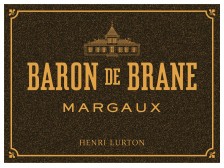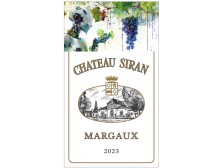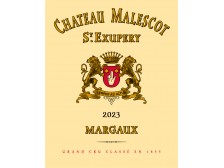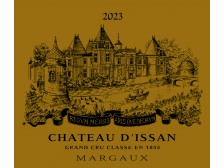2024 Futures
To find out about the week's releases, go to our Latest News page.
-
A family property since the 1950s, the arrival of a new generation has awakened this 32-hectare cru bourgeois in Cussac-Fort-Médoc, between Saint-Julien and Margaux. Revealed in 2012, du Retout climbs another notch in 2018 and 2019 with enthusiastic, sincere and tasty Haut-Médoc, full of fruit and carried by fresh tannins. Congratulations!
More- To keep or to drink:
- Available early 2026
- Potential alcohol:
- 13.05%
- Blend:
- 80% Cabernet Sauvignon, 20% Merlot
-
Second wine of Clos Manou, the Médoc as we like it: generous, sweet and balanced by a good vivacity. A real treat!
More- To keep or to drink:
- Available early 2026
- Potential alcohol:
- 13.95%
- Blend:
- 52% Merlot, 42% Cabernet sauvignon, 3,5% Petit verdot, 2,5% Cabernet franc
-
Dubourdieu property. Unanimously considered as the best and most distinguished of the red Graves, with a grand cru classé grape variety: 2/3 Cabernet Sauvignon and 1/3 Merlot.
More- To keep or to drink:
- Available early 2026
- Blend:
- 75 % Cabernet-Sauvignon, 25 % Merlot
-
Léoville-Barton did not have any attached cru (such as Potensac and Léoville-Las Cases, Pibran and Pichon-Baron, etc.). This "gap" was filled in 2011 with the acquisition of a beautiful historical cru bourgeois de Moulis, Mauvesin, immediately renamed Mauvesin-Barton to show the Barton family's involvement in this new challenge. In all confidence!
More- To keep or to drink:
- Available early 2026
- Potential alcohol:
- 13.40%
- Blend:
- 56% Cabernet sauvignon, 43% Merlot, 1% Cabernet franc
-
Vinified in the cellars of Ch. Ducru-Beaucaillou, this cuvée benefits from the best care. Its higher proportion of Merlot (68%) makes it a wine of pleasure, gourmet and quickly enjoyable.
More- To keep or to drink:
- Available early 2026
- Blend:
- 59% Merlot, 37% Cabernet Sauvignon, 4% Petit Verdot
-
With remarkable consistency, Potensac has been one of the most regular crus bourgeois in the northern Médoc for 30 years, proof of the know-how of the Léoville-Las Cases team (same owner). Its ability to age is always surprising, even and especially in the "early years".
More- To keep or to drink:
- Available early 2026
- Potential alcohol:
- 13.40%
- Blend:
- 48% Cabernet Franc, 35% Merlot, 17% Cabernet Franc
-
The incessant work of Mr. and Mrs. Dief since 2000 is bearing fruit today: in a tense and distinguished style, Clos Manou shines with a vibrant, deep energy, with pure and radiant fruit, combining length and density. Undoubtedly the most beautiful revelation of the northern Médoc in recent vintages.
More- To keep or to drink:
- Available early 2026
- Potential alcohol:
- 13.20%
- Blend:
- 70% Cabernet sauvignon, 22% Merlot, 8% Petit verdot
-
Bought in 2008 by M. Cuvelier (Clos Fourtet), a new era is beginning at Poujeaux under the leadership of Messrs Thienpont and Derenoncourt.
With its racy elegance, natural velvetiness and delicate yet deep texture, Poujeaux is the most Saint-Julien of the Moulis wines, and a model of style for all the crus bourgeois of the Médoc. The vintage is making steady progress, as evidenced by the 94/100 rating awarded by the Revue du Vin de France for its 2020 vintage « voilà un vin très séveux et prometteur ».
More- To keep or to drink:
- Available early 2026
- Potential alcohol:
- 12.5%
- Blend:
- 55% Cabernet Sauvignon, 35% Merlot, 10% Petit Verdot
-
Located at the northern tip of the Médoc, the vineyard of Château La Goulée was abandoned in 2007 when Cos d'Estournel acquired it. The aim was to produce an intensely flavoursome, tasty and charming wine thanks to an almost (90%) pure Merlot grape variety.
The contract was perfectly fulfilled with this magnificent 2019, a real delicacy rated 92/100 by M. Galloni (Vinous).
More- To keep or to drink:
- Available early 2026
- Potential alcohol:
- 12.78
- Blend:
- 64% Merlot, 26% Cabernet Sauvignon, 7% Cabernet Franc, 3% Petit Verdot
-
Although contiguous to Poujeaux, Chasse-Spleen offers another face to Moulis wines, more tannic and, in its first youth, more austere. A great Medoc classic.
Chasse-Spleen expands in 2023 with the acquisition of Brillette, 35 ha of a beautiful terroir of deep gravel in Moulis.
More- To keep or to drink:
- Available early 2026
- Potential alcohol:
- 14%
- Blend:
- 57% Cabernet sauvignon, 30% Merlot, 10% Petit verdot, 3% Cabernet franc
-
We no longer present Sociando-Mallet, which should be in a good place in the cellar of any wine lover, as the quality and above all the regularity of its last thirty vintages are so impressive. Without wishing to underestimate the hard work of the late Mr Gautreau since 1969, it must be said that the terroir, against the Gironde on a gravelly ridge comparable to that of Montrose, is indeed that of a Grand Cru Classé. Unavoidable 2016, the greatest wine of Sociando-Mallet since 1996.
More- To keep or to drink:
- Available early 2026
- Potential alcohol:
- 14%
- Blend:
- 50% Merlot, 47% Cabernet sauvignon, 3% Cabernet franc
-
Renowned for having the best terroir of the Margaux unclassified growths, La Tour de Mons is one of the rare true Margaux Crus Bourgeois at a sweet price, with a faultless regularity for more than 15 years. Bought at the end of November 2019 by the Perrodo family (Ch. Labégorce, Ch. Marquis d'Alesme).
More- To keep or to drink:
- Available early 2026
- Potential alcohol:
- 13.5%
-
Totally surrounded by classified growths, La Gurgue enjoys a privileged terroir, and the attentive care of Mrs Villars (also owner of Ferrière, classified growth of Margaux, and Haut-Bages-Libéral, classified growth of Pauillac), voted Winemaker of the Year 2024 by La Revue du Vin de France. Certainly the best quality/price/pleasure ratio in the appellation.
More- To keep or to drink:
- Available early 2026
- Potential alcohol:
- 13.2%
- Blend:
- 62 % Cabernet sauvignon, 25 % Merlot, 13 % Petit verdot
- Organic certification:
- 2015
-
A small estate (12 ha), carefully tended and vinified with constant regularity, Deyrem Valentin is one of the most typical Margaux crus. Distinguished by the Revue du Vin de France among the hidden nuggets of the Médoc, "its Margaux wines draw a delicious balance".
Promoted to "Cru Bourgeois Supérieur" in 2020.
More- To keep or to drink:
- Available early 2026
- Potential alcohol:
- 14.5%
-
Second wine of Brane-Cantenac, Baron de Brane demonstrates even more than his big brother the progress made in this château over the last 15 years. With a silky smooth 2016, deliciously crisp and juicy on the finish, Baron de Brane is now more than a second wine, it is a brand in its own right!
More- To keep or to drink:
- Available early 2026
- Potential alcohol:
- 13,8%
- Blend:
- 48% Cabernet Sauvignon, 43% Merlot, 7% Cabernet Franc, 1% Carménère, 1% Petit Verdot
-
Even though it is not classified, Siran has been in competition with the classified growths of Margaux for the last ten years, with wines that are at once delicate, firm and full-bodied with age. Aligning successes since 2015, Siran is now at its best, 2020 being its best vintage ever and hailed as such by the Revue du Vin de France: « réussite majeure pour le cru », rated 95/100.
More- To keep or to drink:
- Available early 2026
- Potential alcohol:
- 14%
- Blend:
- 49% Merlot, 41% Cabernet Sauvignon, 10% Petit Verdot
-
The arrival of Mr. Derenoncourt as a consultant in 2002 relaunched Prieuré-Lichine, giving it first of all a better aromatic dimension thanks to a more mature grape. The limitation of yields since 2009 has resulted in additional density and volume, which he lacked to compete with his peers. Progress hailed by the Revue du Vin de France, notably for its 2020, rated 95/100 « the most complete in a long time ».
More- To keep or to drink:
- Available early 2026
- Blend:
- 64% Cabernet sauvignon, 31% Merlot, 5% Petit verdot
-
A small Margaux classified growth (24 ha), Ferrière is a traditional Margaux, frank and pleasant, moderately powerful but perfectly balanced. Its capacity for ageing is undeniable. Certified organicsince 2015, Ferrière was doubly certified biodynamic in 2018, with the Biodyvin and Demeter labels. Awarded Best Winemaker of the Year 2024 by Revue du Vin de France, Claire Villars-Lurtonet has pushed her Margaux cru to the top. Bravo!
More- To keep or to drink:
- Available early 2026
- Potential alcohol:
- 13.2%
- Blend:
- 68 % Cabernet sauvignon, 28 % Merlot, 3,5 % Petit verdot, 0,5 % Cabernet Franc
- Organic certification:
- 2015
-
With a winegrowing past dating back to the 17th century and classified as a 3rd growth in 1855, Château Marquis d'Alesme has nevertheless fallen into decline as it has been bought up (many times).
The Perrodo family (Labégorce, Labégorce-Zédée, La Tour de Mons) acquired it in 2006 in a poor state of repair, with solid ambitions: redistribution of the small 15-hectare vineyard, meticulous work in the vineyard, and a state-of-the-art winery... The vineyard has regained its credentials in recent vintages, as confirmed by the critics' notes and comments.
More- To keep or to drink:
- Available early 2026
-
In 2000, Malescot Saint-Exupéry woke up under the leadership of Michel Rolland. Since then, in a generous and serene style, very rich for a Margaux, he has never ceased to distinguish himself. As the Revue du Vin de France wrote: "In 10 years, it is the wine that has made the most progress among the Margaux wines".
More- To keep or to drink:
- Available early 2026
- Potential alcohol:
- 14%
- Blend:
- 58 % Cabernet Sauvignon, 37 % Merlot, 5 % Petit-Verdot
-
Since 2006, Cantenac-Brown has returned to the forefront of the Margaux scene with wines that are fuller-bodied and deeper than most of its neighbors. A direct competitor of Giscours. "The rising star of Margaux," according to the Revue du Vin de France! The arrival of the new owners in 2019 (Le Lous family) marks a new qualitative progression, with the acquisition of 10 additional hectares and the complete renovation of the winery.
More- To keep or to drink:
- Available early 2026
- Blend:
- 71.5% Cabernet sauvignon, 27% Merlot, 1.5% Cabernet franc
-
Neighbour of Palmer and 3rd Grand Cru Classé like him, Issan offers wines that are clearly different, straighter and crisper. Since 2004, Issan wines have grown in size and body without losing their elegance or denying their Margalais origins.
More- To keep or to drink:
- Available early 2026
- Potential alcohol:
- 13,83%
- Blend:
- 70% Cabernet Sauvignon, 25% Merlot, 2.5% Cabernet Franc, 2.5% Petit Verdot
-
In organic conversion from 2013, Durfort-Vivens was one of the very first classified growths in the Médoc to claim and display organic certification from 2016. M. Bettane is one of its most fervent defenders: "the quality/price ratio remains absolutely unique at this level of quality of terroir and work.
More- To keep or to drink:
- Available early 2026
- Potential alcohol:
- 13.7%
- Blend:
- 92% Cabernet franc, 8% Merlot
- Organic certification:
- 2016
-
Back in top form since the early 2000s, the great Giscours estate has once again become one of the major Margaux growths, in its own distinctive style: very colourful, full-bodied and richly fruity for a Margaux. Its ageing ability has made its reputation as much as its always wise prices.
“The latest vintages are all priorities for the wine-lover,” emphasizes Bettane & Desseauve in its latest guide (2025).
More- To keep or to drink:
- Available early 2026
- Potential alcohol:
- 13.5%
- Blend:
- 71% Cabernet Sauvignon, 23% Merlot, 6% Cabernet Franc
-
Under the direction of Henri Lurton, Brane-Cantenac has gained in recent years in fullness and density and has become one of the leading growths of the appellation along with Palmer and Rauzan-Ségla and even the most authentically Margalese of them all. Let there be no mistake, behind a typically Margalaise elegance and delicacy that encourages tasting it too young, Brane-Cantenac needs time to blossom and reveal itself.
More- To keep or to drink:
- Available early 2026
- Potential alcohol:
- 13.5%
- Blend:
- 77% Cabernet Sauvignon, 20% Merlot, 1% Cabernet Franc, 1% Carménère, 1% Petit Verdot
-
An exceptional terroir classified in 1855 at the top of the second classified growths (with Mouton-Rothschild). Classicism in its purest form, an exemplary Margaux and certainly the cru classé whose style is the closest to that of Château Margaux.
More- To keep or to drink:
- Available early 2026
- Potential alcohol:
- 14.5%
- Blend:
- 85 % Cabernet sauvignon, 13,5 % Merlot, 1,5 % Petit verdot
-
By the quality of the selections, and the creation of a 3rd wine from 2009, Pavillon Rouge would have easily been considered as the Great Wine of Château Margaux only 20 years ago.
More- To keep or to drink:
- Available early 2026
- Blend:
- 79% Cabernet Sauvignon, 14% Merlot, 5% Petit Verdot, 2% Cabernet Franc
-
Palmer, a Cru apart from the Margaux, delivers an original interpretation of the appellation with wines that are always charming, melting and voluptuous, which explains its 50% Merlot grape variety.
More- To keep or to drink:
- Available early 2026
- Organic certification:
- 2018
-
No other vintage can better express the magical association that is so difficult to obtain simultaneously finesse and power. A first growth without rival in its style!
More- To keep or to drink:
- Available early 2026
- Blend:
- 89% Cabernet Sauvignon, 5% Merlot, 4% Cabernet Franc, 2% Petit Verdot
-
Second wine of Lagrange, of an incredible regularity in its quality as in its prices. This classic is an ideal "core of the cellar"!
More- To keep or to drink:
- Available early 2026
- Blend:
- 46% Cabernet sauvignon, 41% Merlot, 13% Petit verdot
































